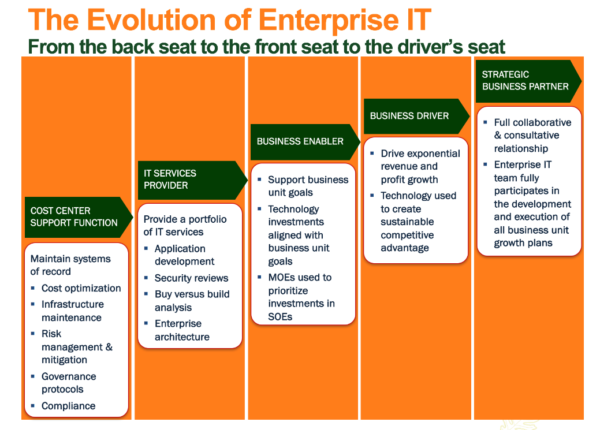
February 22, 2023
In the digital world,
business success is the new strategic imperative

What does success look like for your business in 2023?
As companies embark on their 2023 plans, they are facing a multitude of challenges and a high level of uncertainty about the impact of financial, social, geopolitical, and technological disruptions. This puts added pressure and responsibility on C-Suite leadership teams, boards of directors, and front line workers to be aligned and committed to doing whatever it takes to achieve success.
For an increasing number of companies, success will require the development and deployment of new digital technologies and processes that are essential to delivering exceptional customer, employee, and supply chain partner experiences.
In order to maximize the business value of digital technology, IT will be required to move from a business enabler role to a business driver role as shown on the 5 step chart below:

Evolving IT from a business enabler, relationship management approach to a business driver, success management approach
To advance to the next step of business driver, IT needs to evolve to a business success manager role that actively initiates the deployment of digital technology disciplines that drive increased revenues, margins, and profits. This reinforces another theme I’ve been a proponent of which is IT should be managed as a profit engine, not a cost center support function.
The chart below from Deloitte highlights the differences between the traditional IT model and the new digital technology model:

As there is a lot of content to unpack here, I wanted to look at the specific differences of the top three disciplines.
Business relationship management is about aligning IT and its business partners with resources and budget allocation for key projects and deliverables. This involves demand management, capacity planning and project prioritization.
Business success management is about how digital technology can help businesses meet or exceed a specific set of business goals and desired outcomes. As such, both IT and the business should be held accountable for achieving that result.
IT governance and performance management is about IT’s ability to develop and deliver digital technology on time and on budget. It’s also about IT making sure all the organization’s systems and processes are stable, secure, and in compliance with industry regulations.
Value realization and measurement is about defining the specific business value results and the metrics used to determine if those results were achieved.
Application management is about managing a portfolio of technology projects that support the multiple business and function needs of the organization. The key challenge is to successfully allocate limited resource capacity and budget against competing demand management needs.
Product management is about starting with a clearly defined and understood problem/opportunity and a potential solution. This approach requires replacing the traditional inside-out user interface thinking with outside-in user experience thinking.
The three core elements to business success management

There are three core elements that must be fully embraced and leveraged in order to implement the business success management model:
- Proactive Business Partner Engagement which requires the IT leadership team to actively initiate, and help facilitate, regular face to face meetings with their internal business partners. These discussions should focus on new digital technologies (systems of engagement and systems of intelligence) that can increase customer experience value and better understand and deliver future customer value.
- Product Adoption & Successful Utilization are the new metrics of success rather than customer satisfaction and NPS scores. It is essential to measure the new product or service adoption and utilization rate as a critical measure of success.
- Maximize Digital Technology Value Creation which requires senior IT leaders to reprioritize and redeploy scarce resources and budget away from run-the-business to grow-the-business initiatives. They must incentivize their employees to think like business owners with a P&L mindset, not function heads with a cost center mindset.
Success is about freeing your company’s future from the pull of its past

In my brother Geoffrey Moore’s book Escape Velocity, he documents the challenges that well established companies confront from their legacy cultures and behaviors, and how to let go of traditional customer service/satisfaction playbooks and embrace new customer success playbooks.
He calls this challenge “Crossing the Chasm in the Belly of a Whale.” Simply put, cultural habits and behaviors (good or bad) are very hard to break unless you can identify and adopt some “new rituals” to change them. The new business success management approach outlined above presents a set of new rituals that are designed to free your company’s future from the pull of its past.
As always, I am interested in your comments, feedback and perspectives on the ideas put forth in this blog. Please e-mail them to me on linkedin. And, if this content could be useful to someone you know please share it here:



